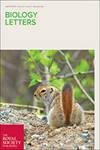新颖的再呼吸适应性延长了半水栖蜥蜴的潜水时间。
IF 2.8
2区 生物学
Q2 BIOLOGY
引用次数: 0
摘要
许多小型无脊椎动物进化出使用气泡来进行水下呼吸,但直到最近,还没有证据表明脊椎动物以类似的方式使用气泡。只有一类脊椎动物--半水栖的阿诺里斯蜥可能是个例外:当受到威胁时,这些蜥蜴会潜入水下,在水下时,它们会在鼻孔上呼出气泡。虽然回气似乎应该是适应性的,可能起到延长蜥蜴在水下避难所停留时间的作用,但这还没有经过实证检验。在这里,我证明了再呼吸可以延长半水栖鼹鼠 Anolis aquaticus 的潜水时间。我在形成气泡的皮肤表面涂抹了一种商用润肤剂,从而阻止了正常再呼吸气泡的形成,以评估气泡对再呼吸周期、鳃泵和潜水时间的影响。允许正常再呼吸的蜥蜴在水下停留的时间比再呼吸功能受损的蜥蜴平均长 32%,这表明再呼吸在水下呼吸中发挥着功能性作用。与回气不同的是,鳃泵不受处理的影响,可能需要进一步研究其在补充水下呼吸中的作用。这项研究为脊椎动物利用气泡进行水下呼吸提供了证据,并提出了有关适应机制和潜在生物启发应用的问题。本文章由计算机程序翻译,如有差异,请以英文原文为准。
Novel rebreathing adaptation extends dive time in a semi-aquatic lizard.
Bubble use evolved in many small invertebrates to enable underwater respiration, but, until recently, there has been no evidence that vertebrate animals use bubbles in a similar manner. Only one group of vertebrates, semi-aquatic Anolis lizards, may be an exception: these lizards dive underwater when threatened and, while underwater, rebreathe a bubble of air over their nostrils. Although it seems that rebreathing should be adaptive, possibly functioning to extend the time that lizards remain in underwater refugia, this has not been empirically tested. Here, I demonstrate that rebreathing serves to extend dive time in a semi-aquatic anole, Anolis aquaticus. I prevented the formation of normal rebreathing bubbles by applying a commercial emollient on the skin surface where bubbles form to assess the impact of bubbles on rebreathing cycles, gular pumps, and dive times. Lizards that were allowed to rebreathe normally remained underwater an average of 32% longer than those with impaired rebreathing, suggesting a functional role of rebreathing in underwater respiration. Unlike rebreathing, gular pumping was unaffected by treatment and may warrant further research regarding its role in supplementing underwater respiration. This study provides evidence that vertebrates can use bubbles to respire underwater and raises questions about adaptive mechanisms and potential bio-inspired applications.
求助全文
通过发布文献求助,成功后即可免费获取论文全文。
去求助
来源期刊

Biology Letters
生物-进化生物学
CiteScore
5.50
自引率
3.00%
发文量
164
审稿时长
1.0 months
期刊介绍:
Previously a supplement to Proceedings B, and launched as an independent journal in 2005, Biology Letters is a primarily online, peer-reviewed journal that publishes short, high-quality articles, reviews and opinion pieces from across the biological sciences. The scope of Biology Letters is vast - publishing high-quality research in any area of the biological sciences. However, we have particular strengths in the biology, evolution and ecology of whole organisms. We also publish in other areas of biology, such as molecular ecology and evolution, environmental science, and phylogenetics.
 求助内容:
求助内容: 应助结果提醒方式:
应助结果提醒方式:


